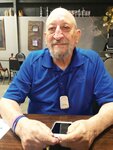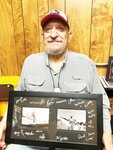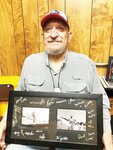


Whether at the scene of nuclear bomb tests in the Pacific or transporting scientists in the brutal weather conditions of Antarctica, former U.S. Naval aviator Myron "Mike" Meier of Gatesville has had some fascinating experiences.
"I'm from a much different era," Meier said. "I went in (to the military) just after the Korean War was over. I graduated from high school in 1953 and decided to join the Navy. I had always had my eye on the Navy for some reason. There were a lot of movies that inspired me."
One of those movies, "The Bridges of Toko Ri" featured Mickey Rooney as a helicopter pilot, which helped further motivate Meier to become a pilot himself.
"Mickey Rooney was one of my heroes because of his small stature, and I was not very big when I was 17."
Meier was a good athlete, however. He was an All State shortstop and also played American Legion baseball. After graduating from high school, he played basketball for Fort Hays State College in Kansas for two years before entering the military.
Meier then went to flight school at Pensacola Naval Air Station, where he learned the basics of flight and picked up a new nickname.
"Flying starts with what they call ground school, where you learn all about aeronautics, engines and how to be an officer," Meier said. He said several of the men in his barracks were from New York, and had gone through the La Guardia School of Aeronautics – a vocational school to train mechanics for commercial aviation. Completing that school gave the men a chance to participate in the Naval aviation program.
"They were all from New York, and they asked where I was from," Meier said. When he told them he was from Salina, Kansas, they told him, "No you're not, you're not wearing overalls and you don't have hay seed in your hair."
When they asked Meier his name, and he told them it was Myron, they said, "No one is named Myron," and decided to come up with a new name for him.
"They batted around about four or five names and then decided I should be called Mike," Meier said. The nickname stuck, and many people know him by that name today.
Several years later, when he was flying and requested to land his plane aboard a ship in the Atlantic, he identified himself by the name Meier. After a pause, the man at the radio aboard the ship answered, "No one is named Myron." It was either one of his classmates from flight school, or someone who had heard Meier’s story.
Meier said even his wife, the former Mary Ann Gorman, who had known him as nothing but Myron, began to call him Mike.
Meier and Mary Ann had five children: David, the oldest, died at age 40; Laura Meier-Marx; Russell; Lisa LeBlanc; and Mary Clarkson.
Meier started his flying career on fixed-wing patrol, and had to serve as a navigator before advancing to the cockpit.
During the height of the Cold War between the United States and the Soviet Union, aircraft were required to enter a narrow zone of the west coast to avoid being challenged by intercepting U.S. aircraft.
"I navigated from Hawaii to San Francisco one time - 13 and a half hours," Meier recalled. The pilot asked Meier where they were and Meier told him, "Somewhere between Seattle and San Diego." However, all joking aside, Meier had successfully navigated the craft to the zone it was supposed to enter.
"It was the starting point of my career, and I knew I didn't want to be a navigator – I joined the Navy to fly," Meier said.
"I was 22 years old, and they had given me a multi-million dollar airplane and entrusted me with the lives of 10 people. I thought that was pretty awesome."
Meier said as an aviator, he went through several deployments, and among the most memorable were being in close proximity to nuclear bomb blasts.
"I got to see six or eight actual nuclear blasts," Meier said. "I saw an atomic bomb explode with all its splendor, if you want to call it that. It was sometimes beautiful but a reminder that the reason we had it (in case of all-out war) was not so wonderful. Let's hope we never have to use it. Those blasts make you feel so insignificant."
The tests were at Bikini Atoll, and one of Meier's jobs was to locate any ships in the area and turn them away from the blast fallout area.
"During the blasts, we put our hands over our eye sockets, and I could see the bones in my hand. The heat from the blast felt like somebody ran a blowtorch across my back. It made me feel very insignificant."
Meier's service in the Pacific during the atomic bomb testing was in 1958.
"After the bomb went off, we had radiation safety duty. We'd wash the plane off and let it sit for a day or maybe a week until the (radiation) half-life was down to where we could use it again."
The military personnel washed down and took showers and carried devices to measure the radiation with them.
"I don't think the military knew that much about radiation at that time," Meier said. "Fortunately, I was able to have four children afterward and all of them are pretty normal."
After patrol squadron duty, Meier served as a flight instructor for three years.
"I thought instructing young pilots was an awesome responsibility," he said. "I had a reputation for being a tough instructor. I had one student, an Italian Navy pilot who in several instances nearly killed us both. I didn't think he'd ever make it. On a critique sheet, he said he didn't like the instructor because 'he thought I was God.'"
Meier responded by saying he did play the role of God for several instances by keeping them from crashing and keeping them alive.
"Being an instructor was another one of my passions," Meier said. "It made me a much better pilot myself."
Meier then had some interesting times in what many people would describe as a frozen wasteland.
"One of my most interesting tours was in the Antarctic," he said. "I went in with a helicopter detachment on an icebreaker."
He said while he was based in the area, there was a tragedy on a mountain in New Zealand. He and his fellow helicopter pilots flew search and rescue missions.
"Being able to help save lives was one of my most rewarding experiences," Meier said.
While stationed in Antarctica, Meier and fellow pilots flew scientists on missions. One of the scientists he flew was a Russian, and he recalled them watching the Cold War era spy thriller "From Russia With Love" together and kidding each other during the film.
Meier recalled flying another scientist when a storm erupted, and despite the adverse conditions – including huge snowflakes swirling about – he was able to get them safely back to base.
"His eyes were as big as saucers when we landed, and after that, he'd never let any other pilot fly him," Meier said. "He insisted that I fly him."
Some of the equipment later used in lunar exploration was first tested in the extreme conditions of the Antarctic.
Although Meier had started in fixed wing planes, he was also an accomplished helicopter pilot. Meier said there was an assumed pecking order where fighter pilots thought they were the best around, while helicopter pilots were usually much more humble.
"I got into it a few times with fighter pilots," Meier said. He would often tell them if they were such hotshots, next time a buddy needed help, try rescuing them in a fixed wing aircraft instead of a helicopter.
"I had some great times and a lot of great memories," Meier said. "Not many have experienced some of the things I was able to experience."
Following his military career, Meier worked for Success Motivation Institute, based in Waco, and then as a nursing home administrator and ombudsman.
He was active for several years in the Silver Haired Legislature, helping seniors to have a voice in government, and is still active in the Gatesville Exchange Club, which promotes patriotism and volunteer service.
“My retirement life has been spent giving back to the community,” Meier said, adding that the oath he took as a military officer to protect and serve his country is something he has “lived by ever since.”